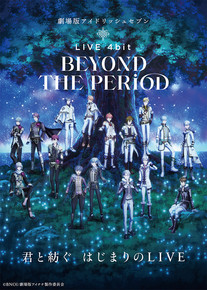Review
by Rebecca Silverman,IDOLiSH7 LIVE 4bit BEYOND THE PERiOD
Anime Film Review
| Synopsis: |  |
||
Boy bands IDOLiSH7, TRIGGER, Zool, and Re:Vale come together for two days of concerts, featuring songs from the multimedia franchise and banter between the guys. |
|||
| Review: | |||
These two films are not a continuation of the television series – they are full-on concerts presented to us like if we were watching a televised broadcast of a live event. Is that a problem? Not in the slightest – although the character interactions and ongoing plotlines are major draws and a large part of what makes the series so good, the music is also a significant attraction. These two films give us the chance to pretend that we live in the show's world, where we could, if we were so lucky, be able to get tickets to see the four main groups live on stage. As far as indulging in a fantasy, it's a pretty great one because we get to indulge in the dream that the series is real. Both concerts offer the same basic experience – the groups perform in the same order each time, with banter in between songs, wearing the same costumes both "nights." There are a few song differences between the two, but music-wise, they're about eighty percent identical. The banter, however, changes from film to film, and both show off a different aspect of the groups. The best example is Tamaki; in Day 1, he's a barely-repressed ball of energy, as caffeine personified. He rambles around the stage, loudly marveling at the sights, and Sogo has to pull him back and try to keep him on task. In Day 2, he's much more under control, as if the adrenaline of the first concert has worn off, and he's back to his usual self, allowing Nagi to become the more expressive I7 member and Iori to get a few more lines in. ŹOOĻ also gets some notable differences between the two films, with Day 2 allowing them to break character just a little bit in the interest of showing their fans how well they get along while still maintaining their stage personas. It's neat and enough to make watching both movies worth it, even if you fast-forward through the songs you've heard before. As might be expected, the dancing looks much better than what we typically get in an episode of the series. Each group has their own style, and I think that ŹOOĻ's works the best – it's more suited to a male body and doesn't rely on anything too flashy, making it feel grounded while conveying the mood of their songs. It probably also helps that they primarily wear black, which eliminates the shadow problems the light-colored costumes suffer from; something about the way the groin area (including inner thighs) is shaded is off, particularly on the I7 outfits. (And the less said about Momo's riding pants, the better.) Still, all of the dancing is much smoother and generally well-choreographed, with the notable exception of the weird umbrella scooping bit in the I7 song that opens both concerts. There is some use of backup dancers, with the best being during Re: Vale's songs, where the dancers are actual backup to Momo and Yuki, helping to fill out the stage. TRIGGER's Gaku is the only person who looks a little wrong in motion-capture CG, but everyone is very clearly recognizable, even when their hair is distinctly different from how we're used to seeing them; Yuki, Iori, and Tamaki all have their long hair pulled back, with Tamaki's being the most drastically different. Camera angles during TRIGGER's numbers can make their triangle formation look off-kilter, but for the most part, there aren't any glaring issues. There are plenty of good details for fans to pick up on in the films, which adds to the value of watching both. Most notable is that Riku and Tenn sing a duet, performing together. We in the anime audience know that they're twins, separated by Tenn's desire to protect his brother (something he neglected to tell Riku), which gives their song something extra – in-world, the audience is unaware of their familial link, so it's a case where we get a little more out of the performance than the fangirls with their light sticks. Momo and Yuki's dynamic also reads differently when you know the truth about Re:Vale (and how Momo replaced Banri). More generally, IDOLiSH7, TRIGGER, and Re:Vale all introduce themselves when they come onstage, but ŹOOĻ makes the audience scream their name, which is very on-brand for both them and how they're positioned within the franchise's world. Both concerts follow the same format for the lineup. I7 opens, performing two songs, followed by ŹOOĻ, then TRIGGER, then Re:Vale, decreasing the number of group members as they go along. For the second half, when everyone performs one song, Re:Vale and TRIGGER swap places, and then everyone comes together for a grand finale and an encore. (Momo and Yuki swap colors for the encore, which is very them.) The entire experience works hard to emulate a broadcast of an in-person event, and it is pretty immersive. It may not be season four continuing the storyline, but it's still a lovely treat and an excellent way to relax for three hours (each film is an hour and a half long). If you're a franchise fan, it's worth watching at least one of them (I like Day 2's lineup a little better) because even if we're not getting a plot, it's still fun to spend time with these characters. |
| Grade: | |||
|
Overall (sub) : B+
Animation : B+
Art : B-
Music : A-
+ Immersive and enjoyable, MC bits are different between the two films. Does a good job with the characters. |
|||
| Production Info: | ||
|
Full encyclopedia details about |
||